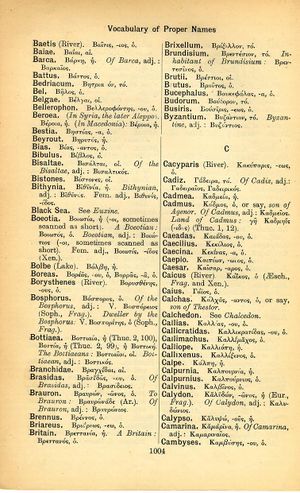Cadmus: Difference between revisions
Ἡμερὶ πανθέλκτειρα, μεθυτρόφε, μῆτερ ὀπώρας ... → All-soothing vine, nurse of the wine, vintage's mother ... (Anthologia Palatina 7.24.1)
(D_2) |
(Gf-D_2) |
||
| Line 1: | Line 1: | ||
{{WoodhouseENELnames | {{WoodhouseENELnames | ||
|Text=[[File:woodhouse_1004.jpg|thumb|link= | |Text=[[File:woodhouse_1004.jpg|thumb | ||
|link={{filepath:woodhouse_1004.jpg}}]]Κάδμος, ὁ, or say, <b class="b2">son of Agenor.</b> | |||
<b class="b2">Of Cadmus</b>, adj.: Καδμεῖος. | <b class="b2">Of Cadmus</b>, adj.: Καδμεῖος. | ||
Revision as of 07:29, 14 August 2017
English > Greek (Woodhouse)
Κάδμος, ὁ, or say, son of Agenor.
Of Cadmus, adj.: Καδμεῖος.
Land of Cadmus: γῆ Καδμηΐς (-ιδος) (Thuc. 1, 12).
Latin > English (Lewis & Short)
Cadmus: i, m., = Κάδμος.
I Son of the Phœnician king Agenor, brother of Europa, husband of Harmonia, father of Polydorus, Ino, Semele, Autonoë, and Agave; founder of the Cadmea, the citadel of the Bœotian Thebes, Cic. Tusc. 1, 12, 28; id. N. D. 3. 19, 48; Ov. M. 3, 14 sq.; id. F. 1, 490; id. P. 4, 10, 55; the inventor of alphabetic writing, Plin. 7, 56, 57, § 192 sqq. (hence letters are called Cadmi filiolae atricolores, Aus. Ep. 29; and Cadmi nigellae filiae, id. ib. 21). He and his wife. Harmonia were at last changed into serpents, Ov. M. 4, 572 sq.; Hor. A. P. 187; cf. Hyg. Fab. 6; 148; 179; 274.—Hence, Cadmi soror, i. e. Europa, Ov. P. 4, 10, 55.—
B Derivv.
1 Cadmēus, a, um, adj., = Καδμεῖος, of or pertaining to Cadmus, Cadmean: Thebae, Prop. 1, 7, 1: juventus, i. e. Thebana, Theban, Stat. Th. 8, 601: Dirce (because in the neighborhood of Thebes), Luc. 3, 175: mater, i. e. Agave, the mother of Pentheus, Sen. Oedip. 1005: cistae, i. e. of Bacchus (because Bacchus was the grandson of Cadmus by Semele), id. Herc. Oet. 595: Tyros (because Cadmus came from Phœnicia), Prop. 3 (4), 13, 7.—Also Carthaginian: gens, stirps, manus = Carthaginiensis, Sil. 1, 6; 1, 106; 17, 582.—
b Subst.: Cadmēa, ae, f. (sc. arx), the citadel of Thebes founded by Cadmus, Nep. Pelop. 1, 2; id. Epam. 10, 3.—
2 Cad-mēĭus, a, um, adj., Cadmean: genitrix, i. e. Agave, Stat. Th. 4, 565: seges, i. e. the armed men that sprang from the dragon's teeth sown by Cadmus, Val. Fl. 7, 282: heros, i. e. the Theban, Polynices, Stat. Th. 3, 366; so, Haemon, id. 8, 458 and 520.—
3 Cadmēïs, ĭdis, f. adj. (acc. Cadmeidem and Cadmeida, Neue, Formenl. 1, 211; 1, 305; voc. Cadmei, ib. 1, 293), = Καδμηΐς, of Cadmus, Cadmean: domus, Ov. M. 4, 545: arx, id. ib. 6, 217: matres, i. e. Theban women, id. ib. 9, 304.—
b Subst., a female descendant of Cadmus; so of Semele, Ov. M. 3, 287; of Ino, id. F. 6, 553.—Plur. Cadmeïdes, the daughters of Cadmus, Agave, Ino, and Autonoë, Sen. Herc. Fur. 758.—
II An historian of Miletus, said to have been the earliest prose writer, Plin. 5, 29, 31, § 112; 7, 56, 57, § 205.—
III A bloodthirsty executioner in the time of Horace, Hor. S. 1, 6, 39; Schol. Crucq.—
A mountain in Caria, Plin. 5, 29, 31, § 118.
Latin > French (Gaffiot 2016)
Cadmus,¹² ī, m. (Κάδμος),
1 fils d’Agénor, frère d’Europe, fondateur de la Cadmée : Cic. Tusc. 1, 28 ; Ov. M. 1, 15 ; F. 1, 490
2 nom d’un bourreau à Rome : Hor. S. 1, 6, 39
3 Milésien qui le premier a écrit l’histoire en prose : Plin. 5, 112
4 montagne de Phrygie : Plin. 5, 118.

